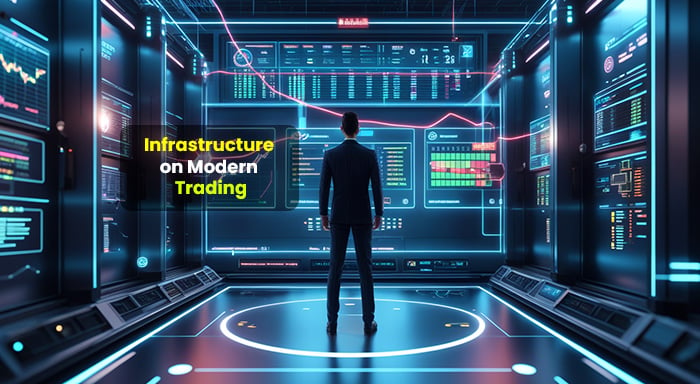In today’s evolving digital financial markets, the quality of trading infrastructure can impact your profits and losses. Traders and financial institutions must carefully evaluate their technological core to sustain a competitive edge, as markets become more digital. Thus, it becomes crucial to understand how infrastructural decisions can affect your trading performance.
Essential Requirements for Trading Infrastructure
The modern trading systems are complicated, so we need a strong infrastructure that can handle multiple tasks at the same time. From placing orders to data management processes, trading excessively relies on technology. Traders who are seeking fast and desired outcomes use professional hosting solutions to maintain functionality of their trading systems. As trading technology evolves, it has changed the way the market functions. Traditional trading hubs have been replaced by digital platforms, where a trade can be made or broken in the smallest fraction of a second. As trading has changed from traditional to digital, a good infrastructure has become more crucial, especially for automated trading.
Different Aspects of Trading Performance
One of the most important aspects of infrastructure is latency. If it takes more time for orders to arrive, exchange it would impact your trading outcomes. That is why ultra-low latency is needed for fast-moving markets. Network stability also plays a very crucial role in trading outcomes, as Instable network connections can lead to opportunity losses or unsuccessful trade executions. A professional trading infrastructure needs backup networks and strong failover mechanisms to continue operations efficiently during market hours.
Just like latency and stable networks, data processing capabilities also have become increasingly important to enhance your trading performance. It needs decent processing power as the trading system analyzes huge amounts of data in real-time.
As the trading environment becomes more demanding, infrastructure must stay up to date to handle heavy workloads while preserving rapid performance.
Secure and Reliable Systems
In this digital world, where cyber threats have become common, cybersecurity is crucial for protecting your trading infrastructure. Cyber security includes encoding, authentication, security breach detection and prevent unauthorized access. Strong security protocols can protect both trading system and confidential data while ensuring seamless operations.
A reliable system is not just about staying active online, it is about how your trading system works during difficult times, like during the time of big economic changes. Make sure your trading operations run continuously without any disruption. In short, we can say a reliable trading system ensures traders that it would work in all market conditions.
Cost Optimization Strategies
If you want to build a high-speed trading system, it can be very costly. There are some effective ways to reduce costs without sacrificing effectiveness.
Resource scaling: this system enables adjustments to shifting market conditions. It ensures effective use of resources during peak and low-traffic hours.
Infrastructure consolidation: it offers an additional way to optimize costs. By integrating trading operations on suitable hardware, traders can save on the overall cost of infrastructure. It also enhances and maintains your performance level.
Monitoring and management: during infrastructure planning, monitoring and maintenance of costs plays a crucial role. Regular updates can optimize your performance and reduce the chance of security threats. To handle these factors traders, use professional infrastructure solutions. These solutions include extensive monitoring capabilities and management tools.
Implementation of Best Practices
A successful trading infrastructure requires strategic planning and execution. In the initial stages you should make sure that your infrastructure meets current requirements and also allows future growth. This adaptability allows trading systems to adapt to the changes in the market without complete replacement of infrastructure.
Geographical evaluation is a vital part of configuration deployment. Easy access to major transmission can drastically hinder trading performance, especially situation-based practices. A thoughtfully implemented server lets users improve connection speeds and lower implementation times.
The need for technical knowledge often plays a crucial role in taking infrastructure decisions for trading firms. However, some traders create and manage internal dedicated teams, while many prefer using comprehensive solutions that offer essential technical guidance. The decision to choose between them relies on a wide range of factors, including the trading amount, strategy intuitiveness, and the accessibility of resources.
Resilient Infrastructure
As technology continues to grow, it significantly hinders trading infrastructure needs. However, these advanced technologies like AI (Artificial intelligence) and ML (Machine learning) require modern, powerful hardware capabilities. This forward-looking infrastructure strategy must necessitate modern requirements.
Another significant aspect of sophisticated trading infrastructure is its advanced technology integration. While conventional committed hardware is still used for certain applications, a hybrid solution is the most preferred solution. This offers both virtual or cloud-based resources, which offer versatility for shifting trading operations.
Hence, consistently evolving regulatory compliance standards drastically diminish infrastructure decisions. These trading platforms are used to manage audit logs, store previous data, and fulfil various regulatory standards. Meanwhile, this raises the need for infrastructure planning to fulfil these requirements without affecting operational effectiveness.
Performance Enhancement
Consistent performance enhancement guarantees high efficiency of trading infrastructure. This process may involve hardware improvement, network configuration, and software patches. These practices are essential for resolving potential challenges and upgrading the entire system's performance.
To establish this level of optimal performance, capacity planning makes all the difference. Consistent evaluation of resource allocation lets you find potential bottlenecks before they hinder trading operations. This strategic approach to anchor infrastructure adapts to the increasing demands properly and effectively.
Monitoring and Analytics
An end-to-end keep tracking offers necessary insights into infrastructure performance. Unlike conventional analysis, which aids sustainable advancement efforts, this real-time insight helps address potential challenges before they hinder trading operations.
Performance indicator monitoring aids in verifying infrastructure efficiency and analysing improvement areas. This metric includes storage management, system resource management, and trading implementation times. Continuous analysis of such indicators helps make informed decisions for infrastructure updates and adjustments.
Conclusion
In this blog, we summarize the key aspects of the strategic and technical importance of infrastructure for traders. Trading infrastructure is not just about technical aspects but also about how strategically you implement your plans. In this digital market era, where every second matters, the effective use of low latency, stability and security can help traders to stand out among competitors. By addressing infrastructure as a crucial company asset that requires continuous improvement, traders can develop a strong foundation for long-term success in today’s digital landscape.



